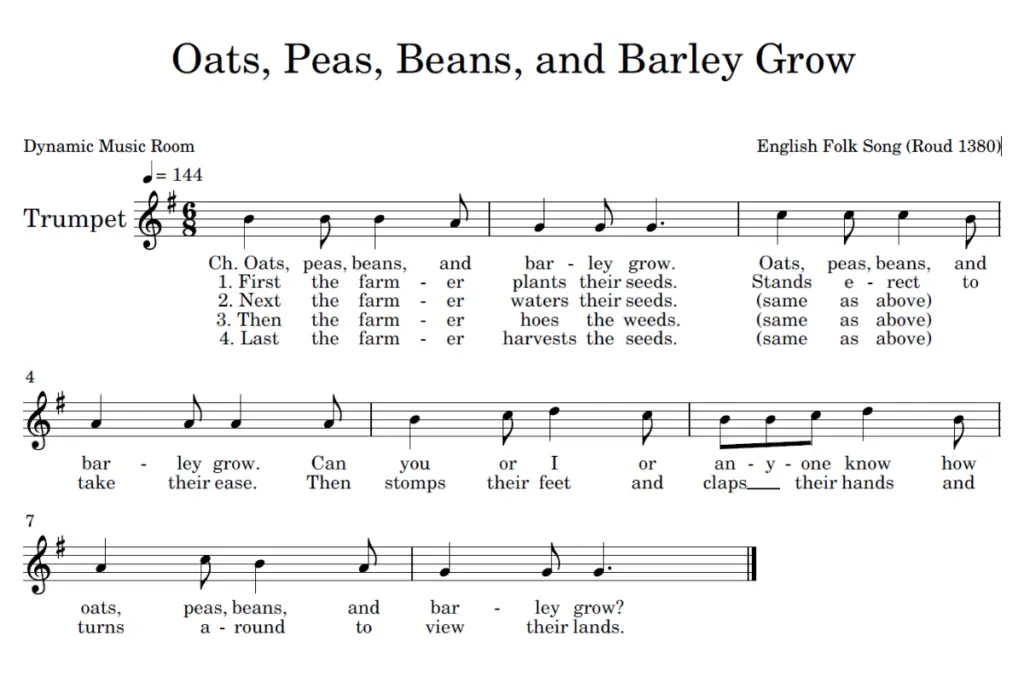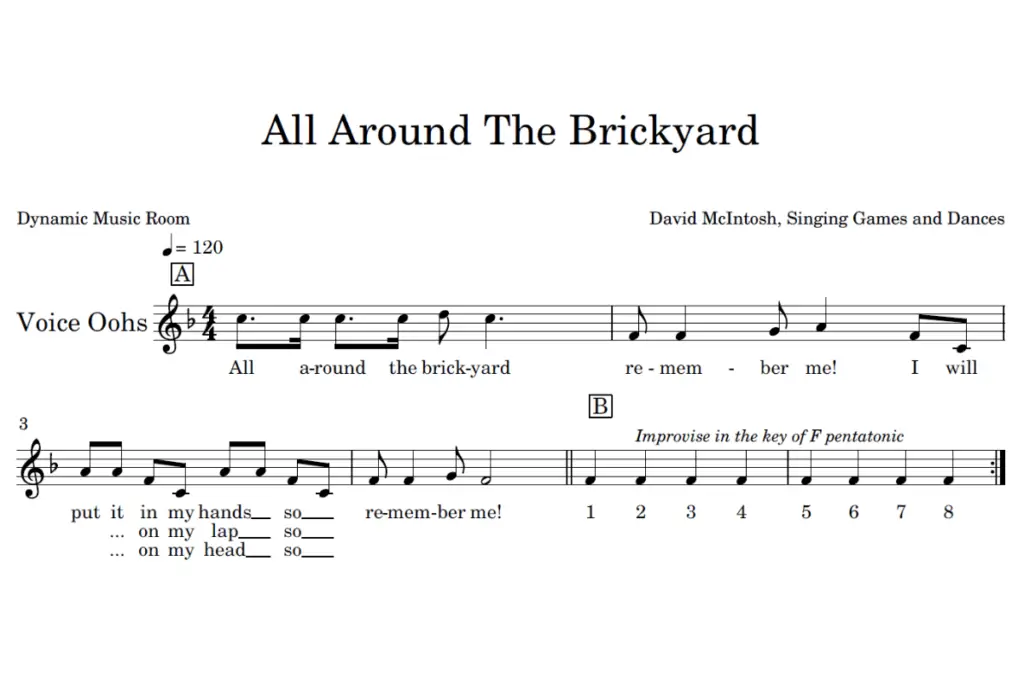Of all the grades I teach, third grade is one of those grade levels I look forward to every single summer.
There’s just something about the perfect balance of wide-eyed 1st-grade wonder and fun with the ability to do so much musically that makes them a joy to teach.
But a lot of people ask me what some of my favorite 3rd grade music lesson plans are, so I thought I’d write up this list for you.
Read ahead for some of my favorite lessons, from simple songs and basic rhythms to music notation and musical form.

Save time with these 60 FREE Music Resources to use in your room right away!
Stop searching the whole internet to find good activities. I’ll help you cut to the chase with my favorite 60 FREE resources.
Table of Contents
Oats, Peas, Beans, and Barley Grow
The song is one of my favorites, and I use it a lot early in the year.
It’s simple but fun to do a lot of movement with, and the steady beat here is quite compelling.
Check out the sheet music below.
For a game with this song, I like to have the class in a circle with one “farmer” in the middle.
During the chorus of the melody, the farmer does a beat motion or dance move the rest of them have to follow.
During the verse, everyone makes the same moves every time.
- Bends over and digs
- Stands up and stretches back
- Stomps feet 2x
- Claps hands 2x
But on the words, “Turns around to view his lands,” the IT person closes their eyes, points a finger, and spins around.
Whoever they land on is the new IT person. Rinse and repeat!
Another game you may try is to add more verses about what the farmers do. Usually, I only have them change the first line and keep the rest the same.
After this is done, it’s pretty fun to have them pick different instruments to match the new words. It leads to a great discussion on timbre.
Here’s an example of what my class came up with the other week:
- First, the farmer plants his seeds = Rhythm sticks
- Next, the farmer waters the seeds = Triangles
- Last, the farmer picks the seeds = Drums
Then, you can play and sing for each part with a different musical texture.

All Around The Brickyard
Here’s another I love that allows for some student choice.
During the A section, students simply play the beat on whatever instrument they want them to.
During the B section, you have some creativity.
I’ve played this with my third-grade students in a couple of different ways:
- Students make up new motions and play them for 8 beats.
- Students improvise melodic patterns on xylophones* on the pentatonic scale.
- Improvise a 4-beat rhythm pattern (or two to make it fit) by saying the rhythm or playing it on the drums.
- Students say their name and something they like during the B section while playing the rhythm.
*Further Reading: Orff Xylophones lessons for all grades
Check out the musical notation here:

Rhythm Memorization
In third grade, I usually like to have my students learn quarter notes, eighth notes, quarter rests, half notes, half rests, sixteenth notes, and whole notes and rests.
Of course, there’s no right or wrong way to build a rhythm sequence; this is just where my students tend to be by this point.
For a rhythm lesson to use with any song, I usually love to challenge their memorization skills.
Of course, this is only one activity out of many, but for some reason, my 3rd-grade kids start to get into this sort of challenge at this age.
This only works if they’re really familiar with the rhythm values you’ll be using.
Then I come up with a list of 4-beat rhythm patterns.
On the first day, we do this challenge; I show them 16 beats of rhythm.
Then I erase one line at a time, but they have to say all 16 beats every time.
Often, the first and third lines will repeat, so they’re only truly memorizing a few lines.
On future days, I’ll have longer and longer rhythms with more variety. I love to keep track of how many beats they can memorize and write it somewhere in my room for the other classes to see.
It encourages and (hopefully healthy) competition.
The farthest I’ve ever seen a class get is to 64 beats of memorized rhythm.
Timbre Sorting
Timbre, or type of sound, is always a critical concept for music classes.
By the time my kids are in third grade, I want them to start listening to all sorts of instruments and begin to sort them in their heads.
A timbre sorting activity is great for this concept and age level.
In small groups or even individually, I give students a blank piece of paper and a list of instruments with a little picture for each one.
Their job is to cut out the words and pictures and sort the instruments into similar timbre or sound categories. (You could also just have them write the names).
If you’re 1-to-1 with technology, you can assign them a site like the Dallas Symphony to check out the different instruments.
Otherwise, you may have to guide them through the listening examples more.
I don’t actually want my kids to sort by instrument family here. Yes, instrument families do have similar timbre, but I’m looking for more out-of-the-box thinking.
After all, the ultimate goal is for critical thinking around the quality of the sounds they hear.
Shake Those ‘Simmons Down
Shake Those ‘Simmons Down is one of those simple play party/folk dances perfect for beginning the year.
I do an adapted version of this classic song with the following lyrics and moves.
| Lyrics | Moves |
| Circle left… | Both circles step to the left. |
| Circle right… | Both circles step to the right. |
| Right hand round… | Partners touch right hands in the air and walk around a small circle two times. |
| Left hand round… | Partners touch left hands in the air and walk around a small circle two times. |
| Shake those ‘simmons down… | Reach forward, grab an invisible tree, and shake it! |
The formation for this song is with students in two circles, an inside and outside. They face their partner, who is the matching person in the other circle.
This way, it works out that after the first two moves, they face their partner.
For an advanced twist, have them step to the right and find a new partner at the end of the whole song, and repeat!
Check out the original musical score at the Holy Names Folk Song Collection.
Match Mine – Solfege (Do, Re, Mi)
Match Mine is a cooperative learning activity with partners.
It can be used with any concept, though I enjoy using it with easy solfege, such as Do, Re, Mi.
Students have a partner, a divider between them, and each has a blank board with a five-line staff.
The leader puts a melodic pattern on their staff board. Then, they have to the pitch pattern on a neutral syllable (such as “bum”).
The guesser has to make the pattern and match it. Once they think they’ve matched, they check their boards.
Then, they switch jobs and take turns making melodic patterns.
Check out more cooperative learning music ideas with this book (link to the book on Amazon).
The Alligator Song
To be honest, I find it hard to find echo songs to use with my older kids. They often get a too-cool-for-school kind of attitude.
The Alligator Song is the great equalizer. I don’t know anybody that doesn’t like it.
I learned it from a YMCA camp I worked at from the guy in this video:
Check out more echo songs for schools in my article here.
Los Machetes
Los Machetes is a Mexican folk dance a lot of music teachers know.
I first learned it from Sonna Longden’s book, More Folk Dance Music For Kids And Teachers.
The directions are free on her website here, and the music is found all over the place.
This link is the version I use.
Here are the basic directions:
- Circle right for 16 beats while clapping above your head
- Circle left for 16 beats while clapping above your head.
- Face the middle, move in for 4 while clapping from the ground to the air
- Move out for 4 while clapping from the air to the ground.
- Danger time moves: Clap, clap hands under right leg, clap, clap hands under left leg, clap, clap hands behind back, clap, clap.
- Repeat step 5
- Step sideways right to the half note beat for 4 while circling right hand in the air
- Step sideways left to the half note beat for 4 while circling left hand in the air.
- Repeat steps 7 and 8
Dynamic Dynamo
This is a silly little challenge I like to do with my kids regarding dynamics.
At this point in their time with me, they’re really familiar with dynamic markings such as:
- Piano
- Mezzo-piano
- Mezzo-forte
- Forte
- Crescendo
- Decrescendo
For this game, I take a longer song, one that’s at least 64 beats long.
I assign the students the job of adding 6 instances of dynamic change in small groups to the song.
Then, they have to be able to sing/play the melody with those changes for the class.
Just make sure they spread out the dynamic changes.
I will also require they have no more than 8 measures of forte as well.
Otherwise, all they want to do is make a song that’s loud the whole time.

